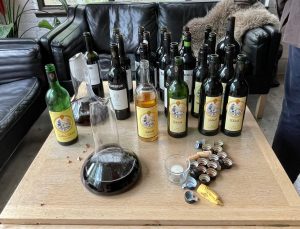I was privileged to join a group of connoisseurs at Melbourne’s elite Wine Table, hosted recently at the Danish Club. The objective was to review 14 vintages of Chateau Tahbilk shiraz.
First though, some background and history of the winery which is quite interesting. Established in 1860, makes Tahbilk the oldest winery in Victoria and the fifth oldest in Australia. It’s wines have been created by of five generations of the Purbrick family, who purchased the property in 1925.
There are around 200 hectares of vineyard on their 1,214 hectare property, which includes 11 kilometres of Goulburn River frontage and eight kilometres of frontage to the Goulburn’s permanent backwaters, wetlands and creeks. Ideal sub soils for producing consistent varieties and also their world renown marsanne.
The first vines – 65 acres – were planted in 1860 by the Goulburn Vineyard Investment Company and the cottages, sheds, stables and blacksmith shop seen on the property today were all constructed between 1860 and 1865.
Throughout the 1870s, with the takeover of the Bear family and the employment of winemaker François Coueslant, more vineyards were planted, wine production boomed and an underground cellar was built. In a twist of fate, the contract for this was awarded to Escott James Purbrick, second-cousin once removed of Reginald Purbrick, who would later purchase the winery.
Success continued until the mid-1880s, when a series of setbacks hit. The vine louse phylloxera decimated the vineyards of Victoria in the late 1800s and economic and political factors saw a sudden decline in the fortunes of the Victorian wine industry in the first decade of the 21st century.
However, in June 1925, Reginald Purbrick purchased the property and the new era of Château Tahbilk began. While Reginald had intended to remove the vines and divide the land into dairy farms, he was persuaded the winery was viable and offered it to his son Eric. Arriving in 1931 from England, where he’d studied law at Cambridge, Eric assumed the role of winemaker the same year. With the help of friends, local winemakers and industry legend Francois de Castella, Eric learnt as much about winemaking and marketing as possible while restoring the cellars and planting phylloxera-resistant vines.
In the late 1970s, John’s son, Alister, having recently graduated from Roseworthy Agricultural College, and with several vintages at Mildara under his belt, took over winemaking duties from George Comi and became General Manager in 1978.
Under his guidance, the quality of the wines soared. While Alister remains CEO his daughter Hayley, the 5th generation of the Purbrick family continues the tradition.
Now we have that out of the way let’s look at my thumbnail tasting notes of each shiraz vintage.
1995 holding up beautifully, soft through palate. 88/100
2001 excellent, well balanced, eucalyptus, mulberries 95
2002 sappy, cardboard, volatile 85
2003 past, slightly oxidised, cork disintegrated
2004 soft, nice tannins, savory, drink now 92
2005 colour fading, soft the palate, but fruit dies quickly 89
2006 dark, rich, full bodied, juicy, blackberry, olives 93
2007 holding well, long on palate, chewy tannins, balanced, 15%, 94
2008 cork, wonderful plums and blackberries dominate, good length 95
2009 cork magnum. cherries, spice, liquorice drinking well now 95
2010 dark colour, big full stewed fruit, yet to come together + 3-5 years 93
2011 unavailable , not made
2012 barnyard nose, soft throughout, no weight 93
2013 big, long full with mulberries, chocolate and sweet up front 95
2014 dark, full flavour with liquorice, pepper, long and balanced +5 years 96
So there you have it. I must mention we had a 2000 Tahbilk marsanne which was almost orange in colour but absolutely delightful. Retaining all the hall marks of marsanne – citrus, lemon, lime, honey hits of peach, pears and apricots. 99/100


